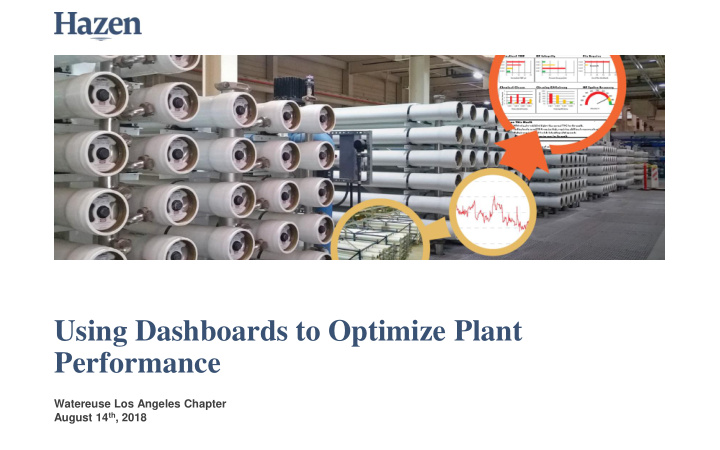



Using Dashboards to Optimize Plant Performance Watereuse Los Angeles Chapter August 14 th , 2018
Proactive vs Reactive Operations Knowledge Operations back Incident of Potential on track Issue Identifying Issue, Field Testing, Water Response Quality, Ordering Parts, Responding to Regulators/Customers TIME
Reuse System Operations Challenges • How do we monitor Critical Control Points (CCP) • How do we best control fouling? • How do we plan chemical cleaning? • How do we optimize pretreatment? • What is the remaining useful life? • Is our system reliable and robust? • Are we meeting customer demand? • Are we meeting regulatory requirements? • Can we produce water more efficiently?
Optimizing Processes by Operating Proactively Asset Management Process Training Optimization Proactive Operations Standard Dashboards Operating Procedures
Creating Dashboards to assist making critical decisions Data Identify Develop Storage, Identify Key Equipment Create Target Handling Performance and Dashboard Values and Cleanup Indicators Instrument Reports (Design) Tags Methods
Overview of KPIs Target Performance KPI Boundary Values Frequency of Measurement
Process Audits develop useful KPIs Process Optimization • Investigate opportunities to improve operations and optimize plant • Identify and review Key Performance Indicators (KPIs)
Membrane Maintenance – CIP Triggers
Facility Reports
Example – Irvine Ranch Water District Graphical User Interface
Project Example – Beverly Hills
Project Example – West Basin RO Dashboard
Key Benefits • Data ‘on demand’ to make quick decisions. • Help manage data from complex reuse systems - Normalization of RO Data, log removal values, large arrays of data. • Save hours of engineering time by automating data handling. • Remove potential for erroneous values. • Information focused and tailored to all levels of operations – management, engineering and operations.
Thankyou Nathan Boyle, PE Principal Engineer Hazen and Sawyer – Los Angeles, CA nboyle@hazenandsawyer.com
Recommend
More recommend